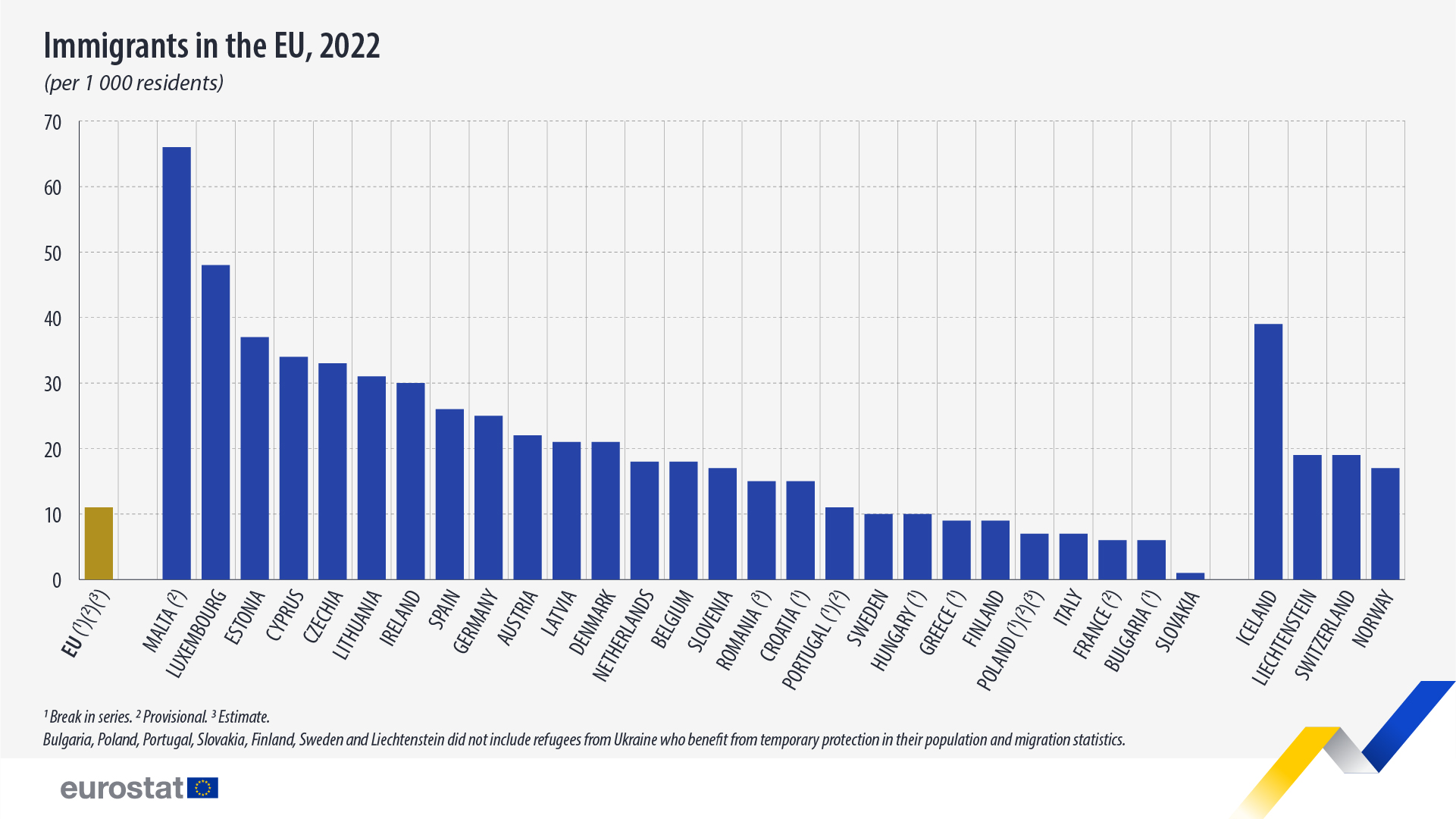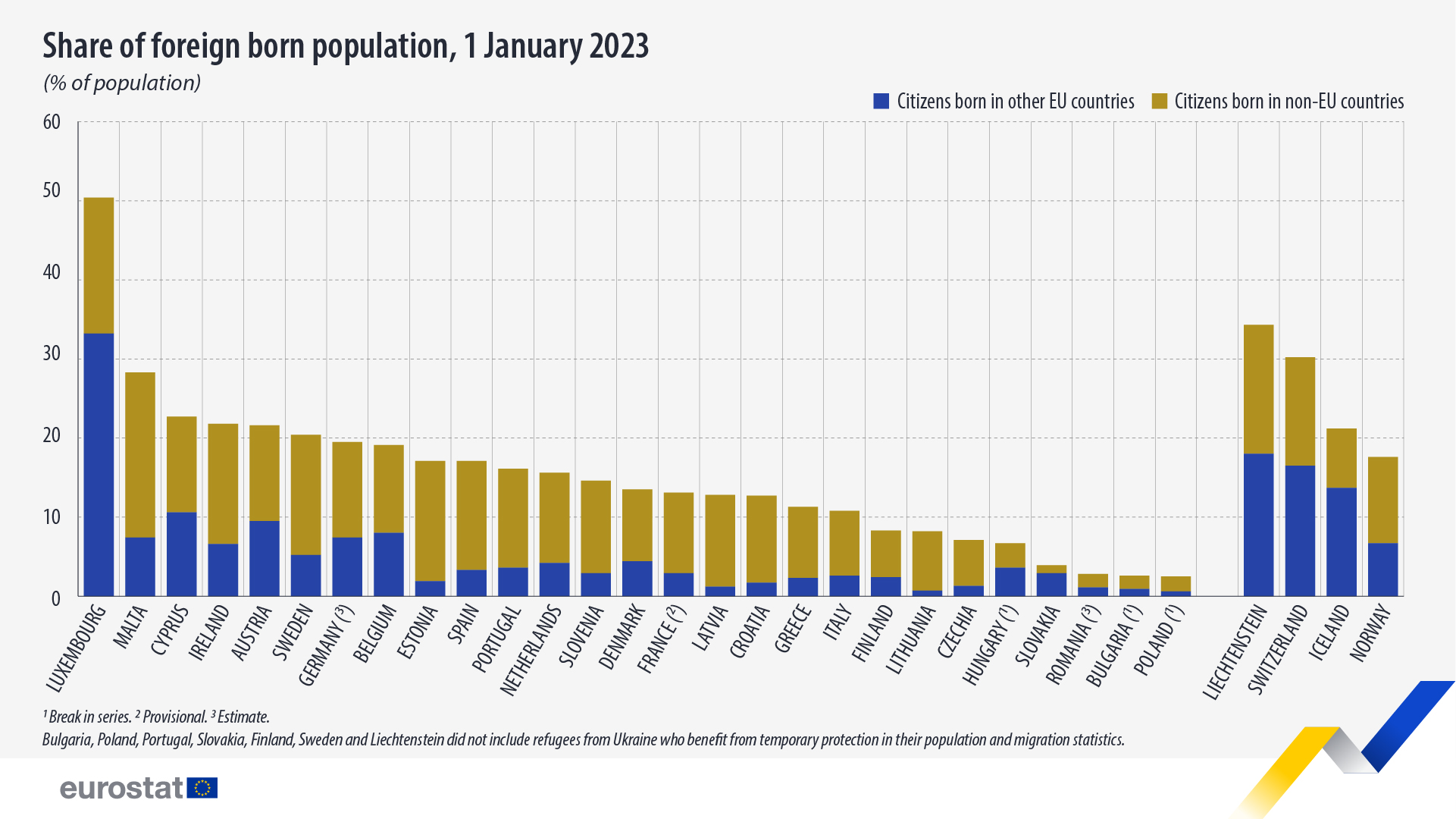EU received 5.1 million immigrants in 2022
In 2022, 5.1 million people immigrated to the EU from non-EU countries, while 1.0 million people emigrated from the EU to destinations outside the EU.
The inflow of immigrants from non-EU countries more than doubled compared to the estimated 2.4 million in 2021. Conversely, the number of EU residents emigrating to countries outside the EU remained stable, with 1.0 million emigrants in 2021.
This information comes from data on migration and migrant population published by Eurostat today. This article presents a selection of findings from the more detailed Statistics Explained article.
Source datasets: migr_imm1ctz and migr_pop1ctz
In 2022, there was an estimated 11 immigrants from non-EU countries per 1 000 residents in the EU.
Relative to the size of the resident population, Malta recorded the highest rate of immigration from EU and non-EU countries in 2022 (66 immigrants per 1 000 residents), followed by Luxembourg (48) and Estonia (37).
In contrast, Slovakia registered the lowest rate of immigration, with 1 immigrant per 1 000 residents, followed by Bulgaria and France, each with 6 immigrants per 1 000 residents.
Foreign-born population in 2023
On 1 January 2023, more than half (50.4%) of the population in Luxembourg was foreign-born. Malta (28.3%) and Cyprus (22.7%) completed the top 3 EU countries with the highest shares of foreign-born population.
In contrast, the lowest shares were recorded in Poland (2.5%), Bulgaria (2.6%) and Romania (2.8%).
In absolute terms, the largest numbers of foreign-born residents (from other EU countries and non-EU countries) were registered in Germany (16.5 million people), France (8.9 million) and Spain (8.2 million).
Source dataset: migr_pop3ctb
In relative terms, Luxembourg had by far the biggest share of residents born in another EU country, 33.2%, followed by Cyprus with 10.6% and Austria with 9.5%.
The lowest shares of residents born in other EU countries, below 1%, were recorded in Poland (0.6%), Lithuania (0.7%) and Bulgaria (0.9%).
When it comes to residents born in non-EU countries, the highest shares were recorded in Malta (20.9%), followed by Luxembourg (17.2%). Ireland, Sweden and Estonia recorded a 15.2% share each.
The lowest shares of non-EU-born residents were registered in Slovakia (1%), Bulgaria and Romania (1.7% each).
For more information
- Statistics Explained article on migration and migrant population
- Thematic section on migration and asylum
- Thematic section on international migration and citizenship
- Database on international migration and citizenship
- Database on population and demography
Methodological notes
- Following Eurostat’s recommendations to ensure consistency of statistics over time, several Member States (Bulgaria, Germany, Ireland, Greece, Spain, France, Croatia, Italy, Cyprus, Lithuania, Hungary, Malta, Poland, Portugal, Norway) have revised or are in process of revising their population or migration time series between the reference years of the population and housing censuses held in 2011 and 2021.
- Guidance on the inclusion of refugees from Ukraine who benefit from temporary protection in the EU in the usually resident population: persons from Ukraine granted temporary protection based on the Commission’s Temporary Protection Directive should be counted as part of the usually resident population. Based on this, those who arrived from Ukraine and were granted temporary protection during the year – and who are believed to still be present at the end of the year – should be counted as immigrants during the year and as part of the migrant stock at the end of the reference period.
If you have any queries, please visit our contact us page.


